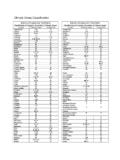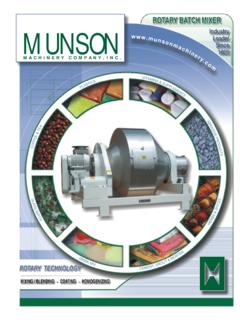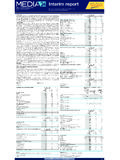Transcription of GUIDELINE ON SUBMISSION OF …
1 Working document RESTRICTED 1 2 3 4 GUIDELINE ON SUBMISSION OF documentation FOR A 5 multisource ( generic ) finished pharmaceutical 6 PRODUCT (FPP): QUALITY PART 7 DRAFT FOR COMMENT 8 9 10 11 12 13 14 World Health Organization 2011 15 All rights reserved. 16 This draft is intended for a restricted audience only, the individuals and organizations having received this draft. The draft 17 may not be reviewed, abstracted, quoted, reproduced, transmitted, distributed, translated or adapted, in part or in whole, in 18 any form or by any means outside these individuals and organizations (including the organizations' concerned staff and 19 member organizations) without the permission of the World Health Organization.
2 The draft should not be displayed on any 20 web site. 21 Please send any request for permission to: 22 Dr. M. Stahl, Quality Assurance & Safety: Medicines, Department of Medicines Policy and Standards, World Health 23 Organization, CH-1211 Geneva 27, Switzerland. Fax: (41-22) 791 4730; e-mail: 24 The designations employed and the presentation of the material in this draft do not imply the expression of any opinion 25 whatsoever on the part of the World Health Organization concerning the legal status of any country, territory, city or area or 26 of its authorities, or concerning the delimitation of its frontiers or boundaries. Dotted lines on maps represent approximate 27 border lines for which there may not yet be full agreement. 28 The mention of specific companies or of certain manufacturers products does not imply that they are endorsed or 29 recommended by the World Health Organization in preference to others of a similar nature that are not mentioned.
3 Errors 30 and omissions excepted, the names of proprietary products are distinguished by initial capital letters. 31 All reasonable precautions have been taken by the World Health Organization to verify the information contained in this 32 draft. However, the printed material is being distributed without warranty of any kind, either expressed or implied. The 33 responsibility for the interpretation and use of the material lies with the reader. In no event shall the World Health 34 Organization be liable for damages arising from its use. 35 This draft does not necessarily represent the decisions or the stated policy of the World Health Organization. 36 Please address comments on this proposal, by 30 July 2011. All comments should be sent to Dr M. Stahl, Prequalification Programme, Quality Assurance & Safety: Medicines, World Health Organization, 1211 Geneva 27, Switzerland, fax: (+41 22) 791 4730 or e-mail: Working document page 2 37 SCHEDULE FOR THE PROPOSED ADOPTION PROCESS OF DOCUMENT 38 : 39 40 41 During the development of this GUIDELINE , 26 manufacturers, who actively participate in the 42 Prequalification Programme, have been contributing and were involved in the consultation 43 process which led to the first draft of this document.
4 In addition, the draft was made available 44 for comments on the WHO web site, both under the Expert Committee meeting 45 documentation , as well as the Prequalification Programme web site. The text was also 46 presented during workshops organized by the Prequalification Programme. The concept has 47 been implemented since September 2010 in SUBMISSION to the prequalification process. To 48 date, the feedback has been Drafting of GUIDELINE by G. Condran and L. Paleshnuik 7 June 2010 Discussion and review of comments within the Prequalification Programme assessment group June 2010 Consolidation of comments and review July 2010 Circulation of revised draft for comments August 2010 Presentation to the forty-fifth WHO Expert Committee on Specifications for pharmaceutical Preparations 18-22 October 2010 Review of text in connection of the new draft working document on Points to Consider for the development of multisource (generics) medicines February-March 2011 Discussion during the informal consultation on development of paediatric and generic medicines 4-6 May 2011 Mailing of revised draft for comments June 2011 Collation of comments received August 2011 Review of comments by a small subgroup September 2011 Presentation to the 46th WHO Expert Committee on Specifications for pharmaceutical Preparations 10-14 October 2011 Any further action as required Working document page 3 50 51 CONTENTS 52 page 53 54 1.
5 Introduction .. 4 55 Background .. 4 56 Objectives .. 4 57 Scope .. 5 58 General principles .. 5 59 Guidance on format .. 6 60 61 2. Glossary .. 6 62 63 3. Quality summaries .. 9 64 Module : Quality overall summary product dossiers (QOS-PD) .. 9 65 Module : Quality information summary (QIS).. 9 66 67 4. Module 3: Quality .. 10 68 Table of contents of Module 3 .. 10 69 Body of data 70 Drug substance (or active pharmaceutical ingredient (API)) .. 10 71 Drug product (or finished pharmaceutical product (FPP)) .. 33 72 Appendices .. 57 73 Regional information .. 57 74 Literature references .. 59 75 76 5. References .. 59 77 78 Appendix 1. Recommendations for conducting and assessing comparative dissolution 79 profiles .. 61 80 Appendix 2. Product quality review requirements for established multisource products.
6 63 81 82 83 84 85 Working document page 4 1. INTRODUCTION 86 87 Background 88 89 WHO Technical Report Series, No. 953, Annex 3 (2009) entitled Procedure for 90 prequalification of pharmaceutical products (TRS No. 953) outlines the procedure and 91 considerations for the process undertaken by WHO in providing United Nations agencies with 92 advice on the acceptability in principle of pharmaceutical products for procurement by such 93 agencies. WHO Technical Report Series, No. 953 states: 94 "This activity of WHO aims to facilitate access to priority essential medicines that 95 meet WHO-recommended norms and standards of acceptable quality." 96 As mentioned in WHO Technical Report Series, No. 953, in submitting an expression of 97 interest (EOI) for product evaluation, the applicant should send to the WHO focal point 98 (together with the other data requirements) a product dossier (PD), in the format specified in 99 the WHO guidance documents on submitting product data and information.
7 100 101 Through the International Conference on Harmonisation (ICH) process, considerable 102 harmonization has been achieved on the organization for the Quality Module of the 103 registration documents with the issuance of the Common Technical Document (CTD) - 104 Quality (ICH M4Q) GUIDELINE . This recommended format in the M4Q GUIDELINE for the 105 quality information of registration applications has become widely accepted by regulatory 106 authorities both within and beyond the ICH Regions. 107 108 This document, GUIDELINE on SUBMISSION of documentation for a multisource ( generic ) 109 finished pharmaceutical product (FPP): quality part, provides recommendations on the 110 quality information for active pharmaceutical ingredients (APIs) and finished pharmaceutical 111 products (FPPs) that should be submitted to WHO to support PDs. 112 113 Alternate approaches to the principles and practices described in this document may be 114 acceptable provided they are supported by adequate scientific justification.
8 It is also 115 important to note that the Prequalification Programme may request information or material, or 116 define conditions not specifically described in this guidance, in order to adequately assess the 117 quality of a pharmaceutical product. 118 119 Objectives 120 121 This GUIDELINE is intended to: 122 assist applicants on the preparation of the Quality Module of PDs for multisource 123 products by providing clear general guidance on the format of these dossiers; 124 fully adopt the modular format of the Common Technical Document - Quality (M4Q) 125 as developed by ICH; and 126 provide guidance on the technical and other general data requirements. 127 128 These measures are intended to promote effective and efficient processes for the development 129 of these PDs by applicants and the subsequent assessment procedures by WHO. 130 131 Working document page 5 Scope 132 133 This GUIDELINE applies to PDs for multisource pharmaceutical products containing existing 134 APIs of synthetic or semisynthetic origin.
9 For the purposes of this GUIDELINE , an existing API 135 is one that has been previously authorized through a finished product by a stringent regulatory 136 APIs from fermentation, biological, biotechnological or herbal origin are covered 137 by other guidelines . 138 139 General principles 140 141 To facilitate the preparation of the PD, this GUIDELINE is organized in accordance with the 142 structure of the Common Technical Document Quality (M4Q) GUIDELINE , as developed by 143 ICH. 144 145 The text of the M4Q (CTD-Q) GUIDELINE has been restated in this GUIDELINE in bold text, 146 verbatim, with minor modifications to accommodate WHO terminology and include certain 147 text that would be appropriate for multisource pharmaceutical products, notably: 148 Drug substance is replaced with active pharmaceutical ingredient or API ; 149 Drug product is replaced with finished pharmaceutical product or FPP ; 150 application is replaced with product dossier or PD ; 151 combination product is replaced with fixed-dose combination or FDC ; 152 clinical batches is replaced with comparative bioavailability or biowaiver batches.
10 153 154 Following the bold text of the M4Q (CTD-Q) GUIDELINE , additional guidance by WHO is 155 provided in plain text to easily distinguish from the ICH text and is included to provide 156 further clarity on WHO s expectations for the content of PDs. This approach is intended to 157 facilitate the identification and origin of the text in the GUIDELINE ( from ICH or WHO). 158 159 The content of this GUIDELINE should be read in conjunction with relevant information 160 described in other existing WHO or ICH reference documents and guidelines . The quality of 161 existing APIs and corresponding multisource products should not be inferior to new APIs and 162 innovator (comparator) FPPs. Therefore, the principles of the ICH guidelines that are 163 referenced throughout this and other WHO guidelines may also equally apply to existing APIs 164 and multisource products. 165 166 Scientific literature may be appropriate to fulfil the requirements for some of the information 167 or parameters outlined in this GUIDELINE ( qualification of specified identified impurities).






